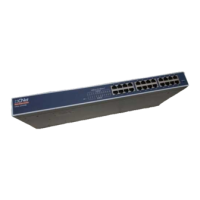
Do you have a question about the CNET CSH-1600W and is the answer not in the manual?
Lists key features like VLAN support, Store-and-Forward, Non-blocking, IEEE802.3x, Auto-MDI/MDI-X.
Describes the front panel layout, including ports and LEDs.
Lists and explains the function of various LEDs on the switch.
Explains how to connect the power cord to the power socket.
Instructions for placing the switch on a desk, including attaching rubber feet.
Guidance on mounting the switch in a rack using provided brackets.
Introduces the smart function and how to access its configuration page.
Connect to the switch's configuration page using its IP address on the local network.
Steps for remote access via the internet, involving mapping a port and running specific software.
Overview of the Vega Proxy Management software interface and its function icons.
Details on configuring server settings such as home directory, index files, and ports.
Describes how to view, add, delete, or modify switches within the LAN for configuration.
Instructions on how to access the server's activity log file.
Information on how to view the help file for assistance.
Describes the server setting window that appears after clicking the server setting icon.
Steps to change the server port from 80 to 8888 for remote access.
Instructions for connecting to the switch from the internet using its WAN IP and the new port.
Shows how device information is displayed on selecting a switch in the management interface.
Steps to start the configuration process by clicking the 'Configure this Device' button.
Details on the default username and password for logging into the switch's configuration interface.
Lists the configurable features available in the smart switch management interface.
How to view the status of each port, including link status, speed, duplex, and flow control.
Explains the columns in the Port Status table: Link Status, Speed, Duplex, and Flow Control.
Steps to select a specific port and view its packet counters.
Details on selecting a port and accessing its counter information via a button.
Instructions on how to reset the port counter values to zero.
Guide to configuring individual port settings like enable/disable, priority, and VLAN ID.
Explains how to configure port settings: ON/OFF, Port Priority, Default VLAN ID, and Tag Mode.
Instructions for configuring Port-based and Tag-based VLANs.
Steps to create and configure Port Based VLAN groups and assign members.
Guide to creating and configuring Tag Based VLANs, including VID and group members.
Instructions for configuring trunk groups, allowing multiple ports to be combined.
How to configure 802.1p and TOS priority levels for Quality of Service.
Details the mapping of 802.1p and TOS values to priority queues (High/Low).
Instructions for configuring Quality of Service (QoS) priority ratios.
Details on setting the priority ratios for QoS, such as 1:2, 1:4, 1:8, or 1:16.
Guide to configuring general system settings like IP address, subnet mask, and gateway.
Explains fields like IP Address, DHCP Client, Firmware Version, and Device Name.
Introduces advanced configuration options, including password changes and factory reset.
Steps to change the administrator login name and password for security.
Procedure to reset all switch settings back to their original factory defaults.
Confirmation step for restoring factory default settings.
Detailed steps on how to use the physical reset button to restore default settings.
Planning considerations before installing the switch, including bandwidth and duplex settings.
Explanation of Fast Ethernet (100BASE-TX) and its cabling requirements.
Information on how the switch learns and stores MAC addresses and table volatility.